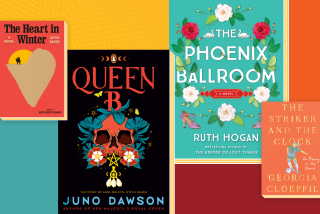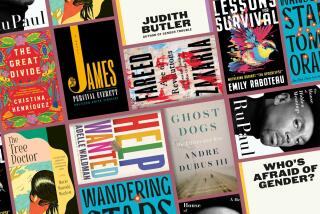Paean to the Mysteries of England’s Shropshire
SHROPSHIRE: A Memoir of the English Countryside by Ellis Peters and Roy Morgan (The Mysterious Press/Warner Books, $35 hardcover).
“Throughout my life,” writes British mystery novelist Ellis Peters, “my home base has never been more than three miles from the village where I was born.” That village (which she describes but doesn’t name) is in Shropshire--the old, romantically-charged name for what is now officially called Salop, a bucolic, historic region northwest of London bordering Wales. (A map would have been useful to non-British readers.) Shropshire, in turn, adds the author, “is simply in my blood, and in the course of creation, the blood gets into the ink.”
Peters, whose real name is Edith Pargeter, is best known for her Brother Cadfael books, featuring the adventures of a 12th-Century crime-solving monk. (The latest, and 19th, volume in the series, “The Holy Thief,” was published simultaneously with this memoir on March 1.) Cadfael’s home is the Benedictine abbey of St. Peter and St. Paul in Shrewsbury, Shropshire’s capital and most famous town, and the mysteries are full of local lore and landscape. The region comes alive even as bodies ooze life.
In “Shropshire,” without a fictional framework, Peters is even better at evoking the atmosphere and texture of the place, describing in her colorful but uncluttered prose its high-hedged lanes and misty valleys, ruined castles and arrogant Georgian mansions, even the long-vanished coal furnaces of its potteries and ironworks (for behind the bucolic beauty, this was the birthplace of the Industrial Revolution).
Roy Morgan’s photographs are pristine and coolly lovely, but they are also strangely unpopulated by human creatures--bloodless, as it were.
A JOURNEY OF ONE’S OWN: Uncommon Advice for the Independent Woman Traveler by Thalia Zepatos (The Eighth Mountain Press, $14.95 paper, $24.95 hardcover).
“My life is a green pasture, bordered by a wooden fence,” writes Zepatos, who is said to have traveled in some 26 countries “via plane, train, donkey, camel, oxcart, bicycle, bus, truck, boat and on foot” (what? no pogo stick?). “Each section represents one of my fears; these fears circumscribe my existence. . . . Once in a while, I gather my strength, jump the rails, and run free into a land that beckons me.” That, I guess, is one reason to travel.
Behind its rather clumsy allusive title, “A Journey of One’s Own” contains some useful information--lists of woman-oriented tour organizers, adventure travel opportunities, guidebooks, discount travel sources, etc.--and the interspersed travel anecdotes, by Zepatos and others, are often both amusing and instructive. And though not all of the author’s advice is exactly “uncommon” (“Organize a trip around something special”), she is particularly good on choosing a traveling companion and on avoiding sexual harrassment (“Learn local ways to shame men,” she advises).
THE TRAVEL TRIVIA HANDBOOK OF ODDBALL EUROPEAN SIGHTS: 100 Curiosities of the Continent and Great Britain by Nino Lo Bello (Citadel Press, $16.95 paper).
A teddy bear museum, a faux- prehistoric cave, a hotel for children only, a Dutch village where everyone still wears wooden shoes--these are some of the unusual places Lo Bello, an occasional contributor to The Times, describes wittily herein for the Europe-bound (or armchair-bound) traveler. Sometimes, though, he’s a bit of a cheat. Are Monet’s gardens at Giverny, the Paris Metro, the Ramblas of Barcelona, the Galleria in Milan, the Vienna Woods and the Beethoven Museum in Bonn really all that “oddball”? And do descriptions of London’s Hyde Park Corner, the art of belly-dancing in Istanbul and the famed Mount Athos monastery in Greece really qualify as trivia?
MY ALBANIA: Ground Zero, edited by Bob Brewer (Lion of Tapelena Press, Inc., $19.95 paper).
Though he learned the Albanian language some years ago at the Defense Language Institute in Monterey, Brewer first visited Albania only in June, 1992, after both Albanian and U.S. restrictions on American travel in that country had been lifted. On this visit, he collected various articles (mostly political), poetry, drawings and other items by Albanian writers and artists. He has assembled them, together with a small selection of declassified U.S. government documents relating to the relationship between that country and this one, into a thin volume which is hardly a travel book but that would make fascinating--nay, indispensible--reading for anyone planning on visiting this most mysterious of European nations.
Quick Trips:
AFRICA ON A SHOESTRING by Geoff Crowther, et al. (Lonely Planet, $27.95 paper). Africa, indeed: Some 54 countries, from Tunisia to South Africa, Senegal to Somalia, even far-flung Mauritius, with notes on everything from game parks to American Express offices to Protestant missions that rent out rooms. A definitive guide.
THE MEDICAL GUIDE FOR THIRD WORLD TRAVELERS, 2nd edition, by Bradford L. Dessery and Marc R. Robin (KWP Publications, $14.95 paper). One of the most comprehensive of the numerous medical travel books now on the market (five others were reviewed in this section on Dec. 13, 1992), including self-diagnosis reference charts, notes on the use of prescription medicines, pre- and post-trip medical checklists and more. Lots on avoiding food-induced illnesses, too.
THE ESSENTIAL GUIDE TO HIKING IN THE UNITED STATES by Charles Cook (Michael Kesend Publishing, $18.95 paper). Brief descriptions and barebones facts on what are said to be all the major hiking trails and areas in the United States, including those in state and national parks and forests. The author is some walker: He once hiked 2,100 miles, from Georgia to Maine.
More to Read
Sign up for our Book Club newsletter
Get the latest news, events and more from the Los Angeles Times Book Club, and help us get L.A. reading and talking.
You may occasionally receive promotional content from the Los Angeles Times.








